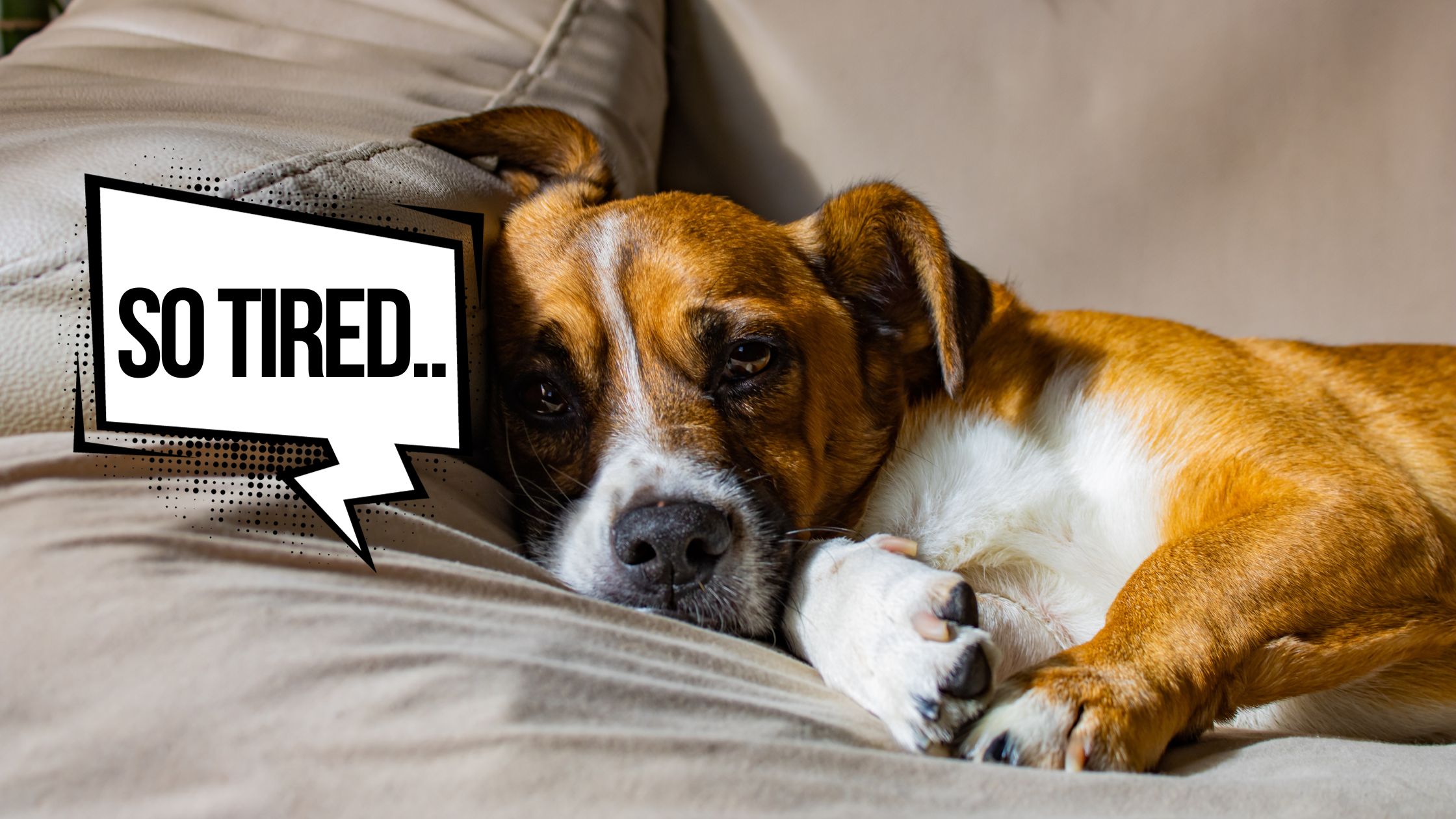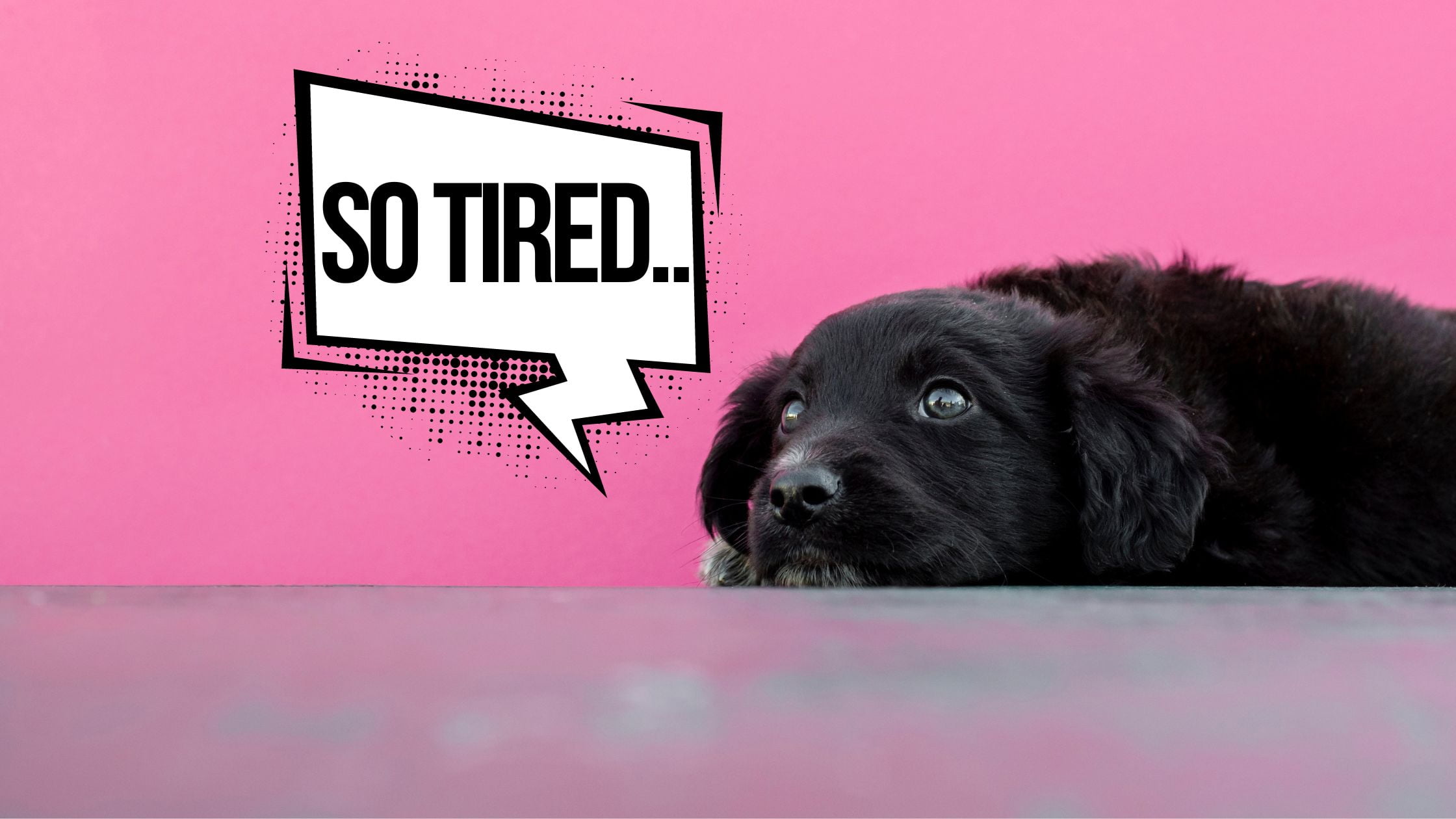Dogs are active creatures that love to play. However, even the most energetic dogs need to rest sometimes. Check how to know if your dog is tired and need a rest!

MAKE SURE IF YOUR DOG IS TIRED FROM THE PLAY
What Signs to Look for if Your Dog is Tired?
- Reduced activity level: If your dog is usually full of energy, but they’re suddenly slowing down or refusing to play, it’s a sign that they may be tired.
- Panting: Panting is a normal way for dogs to cool down, but if your dog is panting excessively, it may be a sign that they’re overheated or tired.
- Yawning: Yawning is a natural way for dogs to stretch and relax. However, if your dog is yawning excessively, it may be a sign that they’re tired.
- Lack of interest: If your dog is usually interested in everything, but they’re suddenly uninterested in their toys or treats, it’s a sign that they may be tired.
- Sleepiness: If your dog is suddenly wanting to sleep more than usual, it’s a sign that they may be tired.
If you notice any of these signs, it’s a good idea to give your dog a rest. Take them for a quiet walk or let them play in a shady spot. You can also try giving them a bone or some other chew toy to occupy them. It’s important to remember that every dog is different.
Some dogs need more rest than others
If you’re not sure how much rest your dog needs, it’s always best to give them more rest than they may need.
Here are some additional tips for knowing if your dog is tired from the play:
- Pay attention to their body language. If your dog is lying down with their legs stretched out, or if they’re panting heavily, it’s a sign that they may be tired.
- Check their gums. If your dog’s gums are pale or pink, it’s a sign that they may be dehydrated and tired.
- Take their temperature. A normal dog temperature is between 100 and 102 degrees Fahrenheit. If your dog’s temperature is higher than that, may be overheated and tired.
By paying attention to your dog’s behavior, body language, and physical signs, you can learn a lot about how they’re feeling and whether or not they need a rest. By giving your dog plenty of rest, you can help them stay healthy and happy.

Tips for helping your dog get a good rest
- Create a comfortable sleeping space for your dog. This could be a crate, a bed, or even just a spot on the floor. Make sure the space is quiet and free from distractions.
- Give your dog plenty of opportunities to exercise during the day. This will help them burn off energy and sleep better at night.
- Avoid exercising your dog too close to bedtime. This can make it harder for them to fall asleep.
- Create a bedtime routine for your dog. This will help them know when it’s time to prepare for bed.
- Make sure your dog is comfortable and relaxed before he go to go sleep. This will help them sleep better.
Follow these tips, to help your dog get a good night’s sleep. In the morning he will wake up feeling refreshed and ready to play.
Which Dog Breeds Get Tired Faster and Need More Rest?
Dogs, often known as our furry companions, come in various shapes, sizes, and personalities. Just like people, different dog breeds have varying levels of energy and endurance. While some breeds seem to have boundless energy, others tire out more quickly and require more rest.
Explore which dog breeds are more prone to fatigue and the reasons behind their need for additional rest. Understanding your dog’s energy levels is essential for providing them with the care and attention they require. Remember that it is very important to know if your dog is tired!
UNDERSTANDING DOG ENERGY LEVELS
Before we delve into the breeds that may get tired faster, it’s important to understand that canine energy levels can be influenced by various factors:
- Breed: Genetics play a significant role in determining a dog’s energy level. Breeds have been selectively bred for specific purposes, which can range from high-energy herding to low-energy lap dog companions.
- Age: Puppies have a lot of energy but can tire quickly, while older dogs tend to have lower energy levels and may need more rest.
- Health: A dog’s overall health, including factors like nutrition and exercise, can affect their energy levels.
- Environment: The environment a dog lives in, including the amount of exercise and mental stimulation they receive, can influence their energy levels.
- Individual Variations: Even within a breed, individual dogs can have different energy levels. It’s essential to consider your specific dog’s needs.
Breeds That Tend to Get Tired Faster
While every dog is unique, there are certain breeds that, on average, tend to tire out more quickly than others.
Here are some of these breeds:
- Bulldog: Bulldogs are known for their short bursts of energy. Due to their brachycephalic (short-nosed) nature, they may struggle to breathe efficiently during extended periods of activity.
- Basset Hound: Basset Hounds have a relaxed demeanor and are more inclined to lounging than vigorous exercise. Their short legs and long bodies make strenuous activity a challenge.
- Pug: Pugs are playful and lively, but their short snouts also limit their ability to maintain high levels of activity for extended periods.
- Shih Tzu: Shih Tzus are small, affectionate dogs that prefer to rest on their owner’s lap.
They have limited stamina for intense activities.
- Bullmastiff: Bullmastiffs are powerful and muscular, but they tend to tire out quickly due to their size and body composition.

Reasons for Faster Fatigue in Certain Breeds
Understanding why some dog breeds get tired faster can help you tailor your care and exercise routines.
Here are a few key reasons:
- Physiological Limitations: Brachycephalic breeds like Bulldogs, Pugs, and Shih Tzus have anatomical limitations that make it harder for them to breathe efficiently, leading to faster exhaustion.
- Muscle Mass and Body Composition: Large, heavy breeds like Bullmastiffs carry more weight and muscle, which can lead to quicker fatigue during strenuous activities.
- Genetic Predisposition: Some breeds were originally bred for specific purposes, such as guarding or companionship, rather than long-lasting physical activities.
Caring for Breeds That Get Tired Faster
If you have a dog from one of these breeds or a breed with similar tendencies, it’s crucial to adapt your care routine to their needs:
- Regular but Short Exercise: Provide regular, moderate exercise sessions, but keep them short to prevent overexertion.
- Avoid Extreme Weather: Brachycephalic breeds are more sensitive to extreme heat, so avoid strenuous activities during hot weather.
- Check their Breathing: Pay close attention how your dog is breathing. If they start panting heavily, it’s time to rest.
- Nutrition: Ensure your dog is on a well-balanced diet that supports their energy needs without overfeeding.
- Mental Stimulation: Offer mental stimulation through puzzle toys and interactive games, which can be as tiring as physical exercise for some dogs.
Final Thoughts on how to know if your dog is tired and In Need of Rest
Understanding your dog’s energy level and breed tendencies is crucial for providing them with the appropriate care and rest they need. Some breeds are more prone to fatigue. Individual variations exist, and your dog’s well-being should always be the top priority.
Whether your dog is a couch potato or a bundle of energy, keep an eye always! Tailoring their care routine to their specific needs will ensure they lead a happy and healthy life. Certain dog breeds may tire out more quickly than others! It’s essential to cater to each dog’s unique energy level and requirements.
By providing the right balance of exercise, rest, and care, you can ensure your canine companion enjoys a happy and healthy life, regardless of their breed’s natural energy level. Hopefully this article showed you how to know if your dog is tired and need a rest!
Be Aware of the Cushing’s Syndrome in Dogs









